It turns out that everything – well, almost everything – can be learned through cooking. Science, history, math, geography, art, and literature are all connected to cooking – to say nothing of the benefits of cooking itself, which involves making something yummy and nutritious to eat.
See below for cross-curricular connections, projects and experiments, storybooks and poems, and many not-just-your-ordinary recipes.
Table of Contents
Cooking and Literature
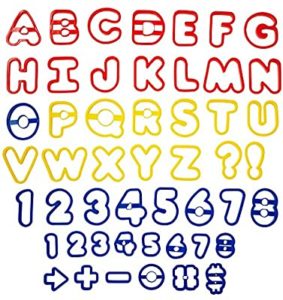 |
Eat the alphabet! Many distributors offer letter and number cookie-cutter sets – such as this fifty-piece collection of colorful plastic cutters including all the letters of the alphabet (upper-case) and numbers 0-9. |
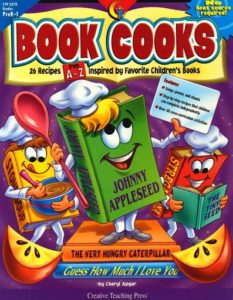
|
Cheryl Apgar’s Book Cooks (Creative Teaching Press, 2002) has a book-related recipe for each letter of the alphabet from A (Apple Smiles) to Z (Zebra Pudding), plus poems, songs, and extension activities. Featured books include The Very Hungry Caterpillar, The Tiny Seed, Green Eggs and Ham, Harold and the Purple Crayon, and Stone Soup. (No heat source required for any of the recipes, which makes things easy for groups of little kids.) For ages 3-7. |
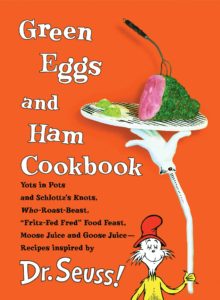
|
By Georgeanne Brennan, the Green Eggs and Ham Cookbook (Random House, 2006) is a terrific collection of Dr. Seussian recipes, paired with catchy passages from the books. Readers learn to make Roast Beast, Cat in the Hat Pudding, and Pink Yink Ink Drink. (See below for more on Green Eggs and Ham.) For ages 7-10. |
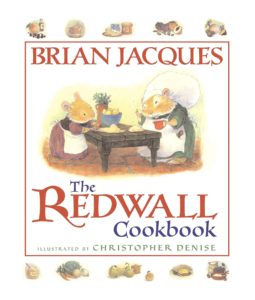
|
Brian Jacques’s The Redwall Cookbook (Philomel, 2005) is a charmingly illustrated collection of recipes from the Redwall series, categorized by season of the year. Learn to make the Abbot’s Special Abbey Trifle, Great Hall Gooseberry Fool, Mole’s Favourite Deeper’n Ever Turnip ‘n’ Tater ‘n’ Beetroot Pie – and, of course, October Ale. For ages 8 and up. |
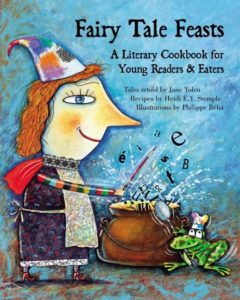
|
Jane Yolen’s Fairy Tale Feasts (Interlink Books, 2009) is an illustrated collection of 20 fairy tales with accompanying recipes. “Cinderella,” for example, is paired with a recipe for pumpkin tarts, “Little Red Riding Hood” features recipes for picnic food (pack a basket), and “Snow White” comes with instructions for baked apples. For ages 8-12. |
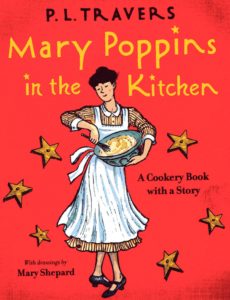
|
In P.L. Travers’s, Mary Poppins in the Kitchen (Houghton Mifflin Harcourt, 2006), the Banks family cook, Mrs. Brill, has been called away – leaving Mary Poppins and the children in charge of the cooking. The frame story features many favorite Poppins characters such as Admiral Boom and the Bird Woman; recipes include Gingerbread Stars, Queen of Puddings, Jam Tarts, and Shepherd’s Pie. For ages 9 and up. |
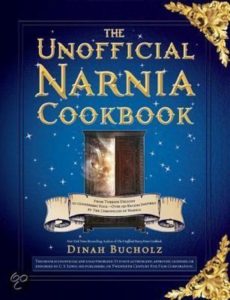
|
Dinah Bucholz’s The Unofficial Narnia Cookbook (Sourcebooks Jabberwocky, 2012) – a midnight-blue book with gold corners – is a collection of recipes and menus based on C.S. Lewis’s Narnia books. Make plum cake, ginger beer, and Turkish delight. For ages 9 and up. |
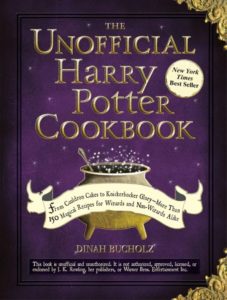
|
Dinah Bucholz’s Unofficial Harry Potter Cookbook (Adams Media, 2010) – purple with gold corners – is a collection of 150 recipes based on the Potter books, among them Hagrid’s Rock Cakes, Petunia’s Pudding, Treacle Tart, and Molly’s Meat Pies. Included with each recipe is a snippet of British food history. For ages 10 and up. |
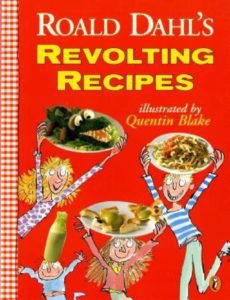
|
By Roald Dahl and Felicity Dahl, with wonderful illustrations by the incomparable Quentin Blake, Roald Dahl’s Revolting Recipes (Puffin, 1997) is a collection of (actually yummy) recipes from Dahl’s books, among them Snozzcumbers, Frobscottle, Hot Frogs, Lickable Wallpaper, Eatable Marshmallow Pillows, Candy-Coated Pencils for Sucking in Class, and Stickjaw for Talkative Parents. A hoot for all ages. |
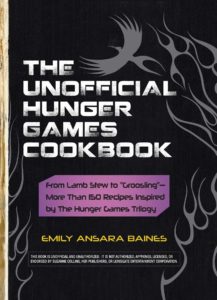
|
By Emily Ansara Baines, The Unofficial Hunger Games Cookbook (Adams Media, 2011) is a collection of 150 recipes based on Suzanne Collins’s Hunger Games trilogy – books which, frankly, I would not have expected to generate much in the way of recipes. Among those that it did: Mrs. Everdeen’s Breakfast of Mush, Katniss’s Lamb Stew with Dried Plums, Apple-Smoked Groosling, and Annie and Finnick’s Wedding Cake. For ages 13 and up. |
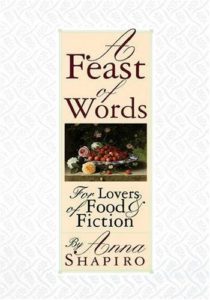
|
In Anna Shapiro’s A Feast of Words: For Lovers of Food and Fiction (W.W. Norton; 1996), classic works of literature are paired with creative recipes. Featured books include Anna Karenina, Moby Dick, Jane Eyre, Ethan Frome, Emma, and David Copperfield. Literary discussion and kitchen projects for teenagers and adults. |
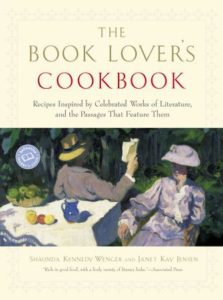
|
By Shaunda Kennedy Wenger and Janet Jensen, The Book Lover’s Cookbook (Ballantine Books, 2005) is a collection of 170 recipes for foods featured in classic books (both for children and adults), paired with literary quotations. If your kids have clamored to try the White Witch’s Turkish Delight or wondered about the Cratchit family’s carrot pudding, this is the book for you. For all ages. |
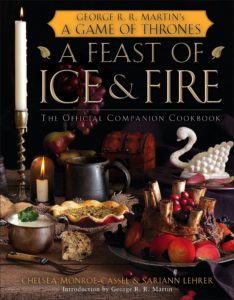
|
By Chelsea Monroe-Cassel and Sarian Lehrer, A Feast of Ice and Fire: The Game of Thrones Companion Cookbook (Bantam, 2012) provides photo-illustrated recipes (categorized by region), plus basic information on stocking a medieval-style kitchen. Included is a list of modern substitutes for things you can’t possibly get, such as auroch. For older teenagers and adults. |
